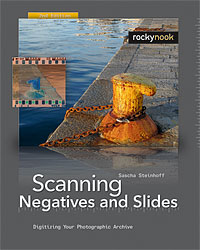
Scanning Negatives and Slides – Digitizing Your Photographic Archive
Author: Sascha Steinhoff
Publisher: RockyNook
ISBN: 13: 978-1-933952-30-7
Price: $44.95 US/CAN
Page Count: 239
http://www.rockynook.com
I guess that I can be classified as an “old-timer” in that I have tons of negatives and slides from decades of taking pictures with a 35mm camera and in the case of a large number of the pictures, developing my own negatives, slides and printing out my own photographs. (My thanks to the USO who provided the instruction and equipment a long, long time ago) Add to my own photographs are those taken by parents, family and friends over the years as I was growing up, and you can wind up with hundreds and hundreds of pictures that need to be preserved, just in case the kids decide they want to view the “ancient” past of their father. With the changes that have been occurring in the past fews years and also most recently with the apparent demise of 35mm film, the inability of having film developed easily and cheaply, and probably more important, the explosion of digital photography, I thought that it was about time I started to better preserve my windows to the past.
The big question that hit me once I started to go through my collection of photographs was “How do I do this easily and without taking up all of my spare time?” So I began to search for a source that could provide me with some answers to my questions and maybe make my task easier to accomplish. When the chance came to read and review Sascha Steinhoff’s book on Scanning Negatives and Slide – Digitizing Your Photographic Archive, I jumped at the chance. To start off, I have the capability to scan using a HP Scanjet 3970 scanner that has served me well for the past few years when I needed to scan something, plus I can use a HP All-in-One OfficeJet J6480, the newest add-on to the computing gear that I have. The first thing I looked for in Mr. Steinhoff’s book was an explanation of scanners, negative scanning, slide scanning and options that are available for the user. The first chapter covers this quite nicely. His last section of the first chapter also provided the option to the reader of the consideration of having your photographs and negatives digitized by professional scanning services.
Now, as I started to get more into the book, the first thing I noticed was that Mr. Steinhoff definitely has a preference for Nikon equipment. I know that his suggestions can be adjusted to fit other equipment, but one would think it would be presented as generic in nature and not specific to a particular brand. Secondly, I look at explanations in a book to see how they are presented and at times, Mr. Steinhoff’s explanations tend to be just a tad bit intense for someone who may just be looking for a more simple, easy-to-understand explanation. Another point for possible users is that the book itself is written for those using a “PC” and while things are blurring along those lines and one can always adjust this to the use of a Mac, this may present an issue for some readers. The book also has a DVD that contains software (shareware), i.e. VueScan (Linux/Windows/Mac), Picture Editing software and Photoshop Plug-ins for both Windows and Mac, and additional items such as Image Databases, Sample Scans Filmscanner and Sample Scans Flatbed Scanner.
The book itself contains 15 chapters, plus a glossary. The breakdown is as follows:
1. Introduction
2. Performance Characteristics of Film Scanners
3. Scanning Film
4. File Formats
5. Color Management in Theory and Practice
6. Scanning Methods
7. Scanning Correction Filters in Detail
8. Configuring the Scanning Software
9. Nikon Scan
10. VueScan
11. SilverFast
12. Scan Workflows
13. Nikon Capture NX 2
14. Correcting with Photoshop and Photoshop Plug-ins
15. Backup
I might suggest that if you haven’t as yet purchased any scanners or software, then this book may be what you need to review prior to making the purchase or if you have the background and want to improve your equipment and your skills, then you may also wish to consider the book. I was left after going through the book with still unanswered questions. What do you do when you don’t have any higher priced or higher end equipment to do scans? Can I utilize the software and hardware I already have or am I going to incur additional costs? What do you do if you just have a flatbed scanner and your experience with scanning is not at the level of Mr. Steinhoff? Will the results I get from my equipment provide me with the results I’m looking for or do I need to re-evaluate my process and consider upgrading? While Mr. Steinhoff’s information is at times useful, how many readers are going to be able to easily use it to accomplish what they want to do?
So to review:
I would have liked to see more generic information and solutions on some of the issues that I’ve already encountered, such as fading, dust and scratches, color washout and other possible software/hardware solutions. As I had said earlier, some of Mr. Steinhoff’s writing is intense and data driven, yet there are sections in the book that are informative and come across quite well for those seeking information on scanning that can be easily assimilated and used quite readily. However, if you are looking for a book to get you through the challenge of scanning your pictures and negatives yourself, this book may not provide the answers you may be seeking.
email – MyMac Magazine – Twitter – Advertise – Reviews Archive – Podcast

Leave a Reply
You must be logged in to post a comment.